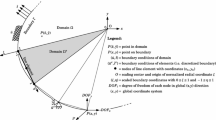Abstract
The scaled boundary finite element method (SBFEM) is a recently developed numerical method combining advantages of both finite element methods (FEM) and boundary element methods (BEM) and with its own special features as well. One of the most prominent advantages is its capability of calculating stress intensity factors (SIFs) directly from the stress solutions whose singularities at crack tips are analytically represented. This advantage is taken in this study to model static and dynamic fracture problems. For static problems, a remeshing algorithm as simple as used in the BEM is developed while retaining the generality and flexibility of the FEM. Fully-automatic modelling of the mixed-mode crack propagation is then realised by combining the remeshing algorithm with a propagation criterion. For dynamic fracture problems, a newly developed series-increasing solution to the SBFEM governing equations in the frequency domain is applied to calculate dynamic SIFs. Three plane problems are modelled. The numerical results show that the SBFEM can accurately predict static and dynamic SIFs, cracking paths and load-displacement curves, using only a fraction of degrees of freedom generally needed by the traditional finite element methods.
Similar content being viewed by others
References
Ingraffea, A.R., Gerstle, W.H., Gergely, P., Saouma, V.: Fracture mechanics of bond in reinforced concrete. ASCE J. Struct. Eng. 110(4), 871–890 (1984)
Swenson, D.V., Ingraffea, A.R.: Modeling mixed-mode dynamic crack propagation using finite elements: Theory and applications. Comput. Mech. 3, 381–397 (1988)
Yang, Z.J., Chen, J.F., Proverb, D.: Finite element modelling of concrete cover separation failure in FRP plated RC beams. Construct Building Materials 17(1), 3–13 (2003)
Yang, Z.J., Chen, J.F.: Finite element modelling of multiple discrete cohesive crack propagation in reinforced concrete beams. Eng. Fract. Mech. 72(14), 2280–2297 (2005)
Xie, M., Gerstle, W.H.: Energy-based cohesive crack propagation modelling. ASCE J. Eng. Mech. 121(12), 1349–1458 (1995)
Yang, Z.J., Chen, J.F.: Fully automatic modelling of cohesive discrete crack propagation in concrete beams using local arc-length methods. Int. J. Solids Struct. 41(3–4), 801–826 (2004)
Gerstle, W.H., Abdalla, J.E.: Finite element meshing criteria for crack problems. ASTM STP 1074, ASTM, Philadephia, 509–521 (1990)
Saouma, V.E., Schwemmer, D.: Numerical evaluation of the quarter-point crack tip element. Int. J. Numer. Meth. Eng. 20(9), 1629–1641 (1984)
Hellen, T.K.: On the method of virtual crack extension. Int. J. Numer. Meth. Eng. 9(1), 187–207 (1975)
Xie, M., Gerstle, W.H., Rahulkumar, P.: Energy-based automatic mixed-mode crack propagation modelling. ASCE J. Eng. Mech. 121(8), 914–923 (1995)
Yang, Z.J., Chen, J.F., Holt, G.D.: Efficient calculation of stress intensity factors using virtual crack extension technique. Comput. Struct. 79(31), 2705–2715 (2001)
Wawrzynek, P.A., Ingraffea, A.R.: An interactive approach to local remeshing around a propagation crack. Finite. Element. in Anal. Des 5, 87–96 (1989)
Bocca, P., Carpinteri, A., Valente, S.: Mixed-mode fracture of concrete. Int. J. Solid Struct. 27(9), 1139–1153 (1991)
Moes, N., Dolbow, J., Belytschko, T.: A finite element method for crack growth without remeshing. Int. J. Numer. Meth. Eng. 46(1), 131–150 (1999)
Huang, R., Sukumar, N., Prevost, J.H.: Modeling quasi-static crack growth with the extended finite element method Part II: Numerical applications. Int. J. Solids Struct. 40(26), 7539–7552 (2003)
Portela, A., Aliabadi, M.H., Rooke, D.P.: Dual boundary element incremental analysis of crack propagation. Comput. Struct. 46(2), 237–247 (1993)
Belytschko, T., Lu, Y.Y., Gu, L.: Crack propagation by element-free Galerkin methods. Eng. Fracture Mech. 51(2), 295–315 (1995)
Rao, B.N., Rahman, S.: A coupled meshless-finite element method for fracture analysis of cracks. Int. J. Pressure Vessels Piping 78(9), 647–657 (2001)
Wolf, J.P.: The Scaled Boundary Finite Element Method. John Wiley and Sons, Chichester, 2003
Song, C.M., Wolf, J.P.: Semi-analytical representation of stress singularities as occurring in cracks in anisotropic multi-materials with the scaled boundary finite-element method. Comput. Struct. 80(2), 183–197 (2002)
Song, C.M.: A super-element for crack analysis in the time domain. Int. J. Numer. Meth. Eng. 61(8), 1332–1357 (2004)
Deeks, A.J., Wolf, J.P.: An h-hierarchical adaptive procedure for the scaled boundary finite-element method. Int. J. Numer. Meth. Eng. 54(4), 585–605 (2002)
Yang, Z.J., Deeks, A.J., Hao, H.: A Frobenius solution to the scaled boundary finite element equations in frequency domain. Civil Engineering Research Report C: 2161, The University of Western Australia, 2006
Deeks, A.J., Wolf, J.P.: A virtual work derivation of the scaled boundary finite-element method for elastostatics. Comput. Mech. 28(6), 489–504 (2002)
Erdogan, F., Sih, G.C.: On the crack extension in plate under in plane loading and transverse shear. J. Basic Eng. ASME 85(4), 519–527 (1963)
Hussain, M.A., Pu, S.L., Underwood, J.H.: Strain energy release rate for a crack under combined mode I and II. Fracture Analysis STP 560, ASTM (1974)
Sih, G.C.: Strain-energy-density factor applied to mixed-mode crack problems. Int. J. Fracture 10(3), 305–321 (1974)
Lee, S.H., Song, J.H., Yoon, Y.C., Zi, Z., Belytschko, T.: Combined extended and superimposed finite element method for cracks. Int. J. Numer. Meth. Eng. 59(8), 1119–1136 (2004)
Arrea, M., Ingraffea, A.R.: Mixed-mode crack propagation in mortar and concrete. Report No. 81–13: Department of Structural Engineering, Cornell University (1982)
Chirino, F., Gallego, R., Saez, A., Dominguez, J.: A comparative study of three boundary element approaches to transient dynamic crack problems. Eng. Anal. Boundary Elements, 13(1), 11–19 (1994)
Hibbitt, Karlsson and Sorensen Inc. ABAQUS/Standard User Manual V6.5 (2004)
Author information
Authors and Affiliations
Corresponding author
Additional information
The project supported by the National Natural Science Foundation of China (50579081) and the Australian Research Council (DP0452681)
The English text was polished by Keren Wang.
Rights and permissions
About this article
Cite this article
Yang, Z. Application of scaled boundary finite element method in static and dynamic fracture problems. Acta Mech Mech Sinica 22, 243–256 (2006). https://doi.org/10.1007/s10409-006-0110-x
Received:
Accepted:
Published:
Issue Date:
DOI: https://doi.org/10.1007/s10409-006-0110-x




